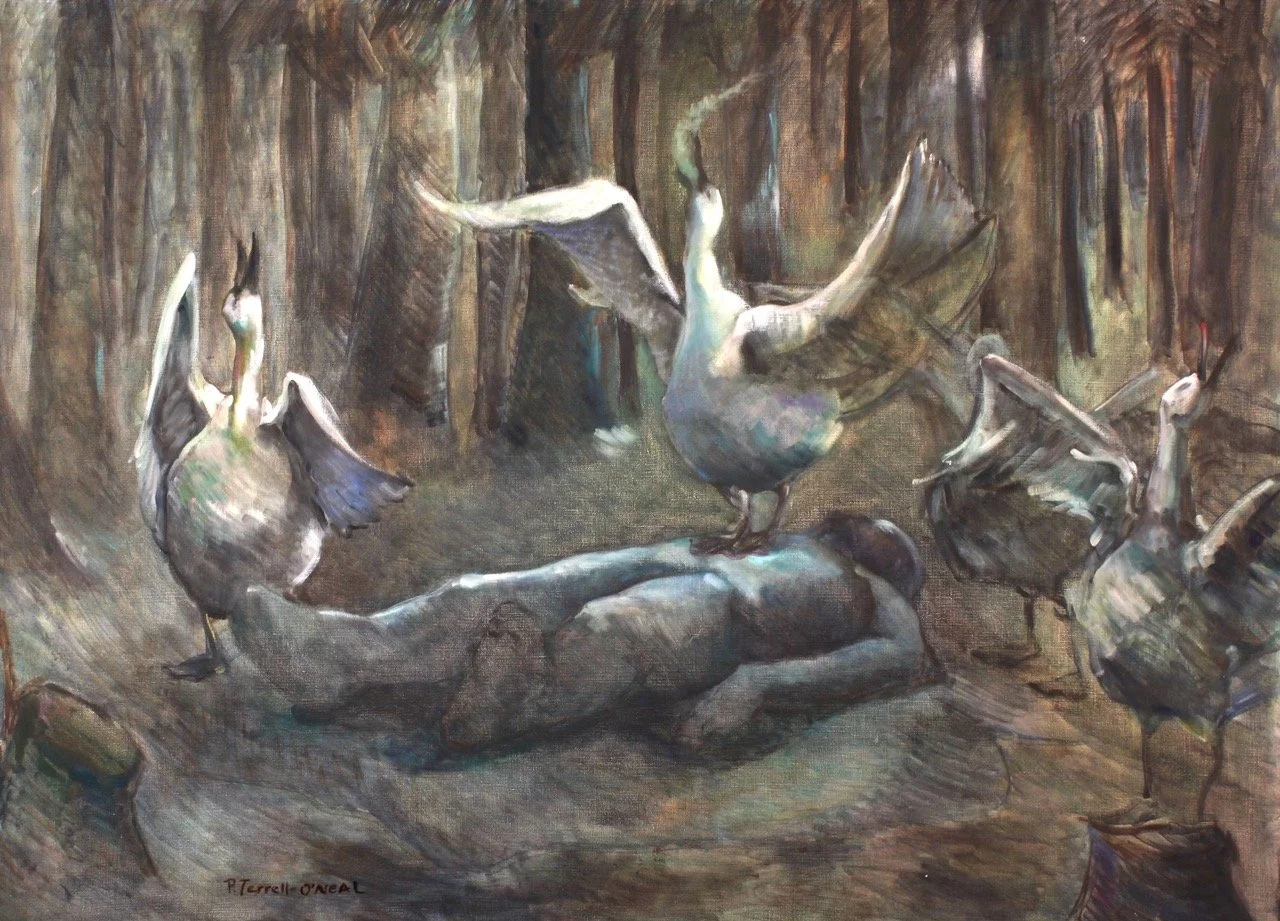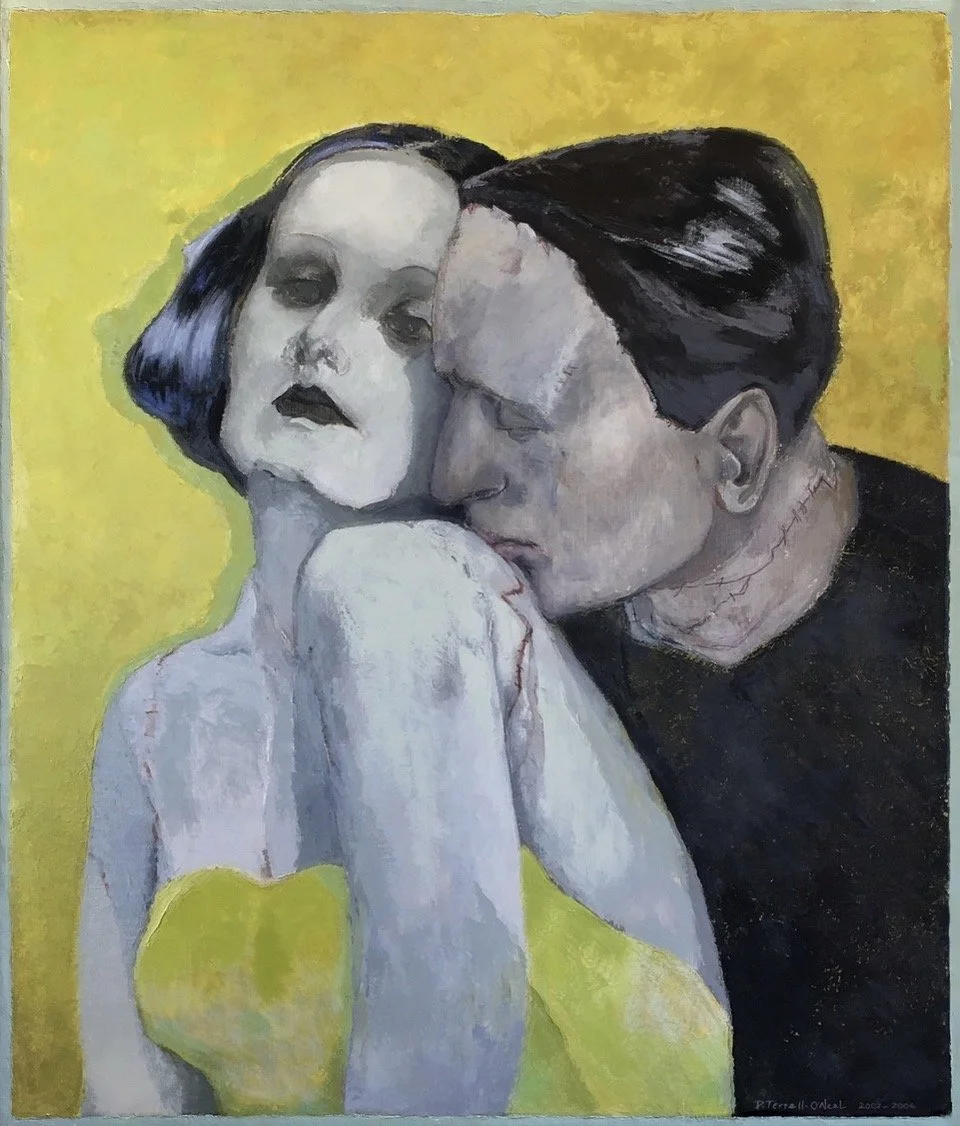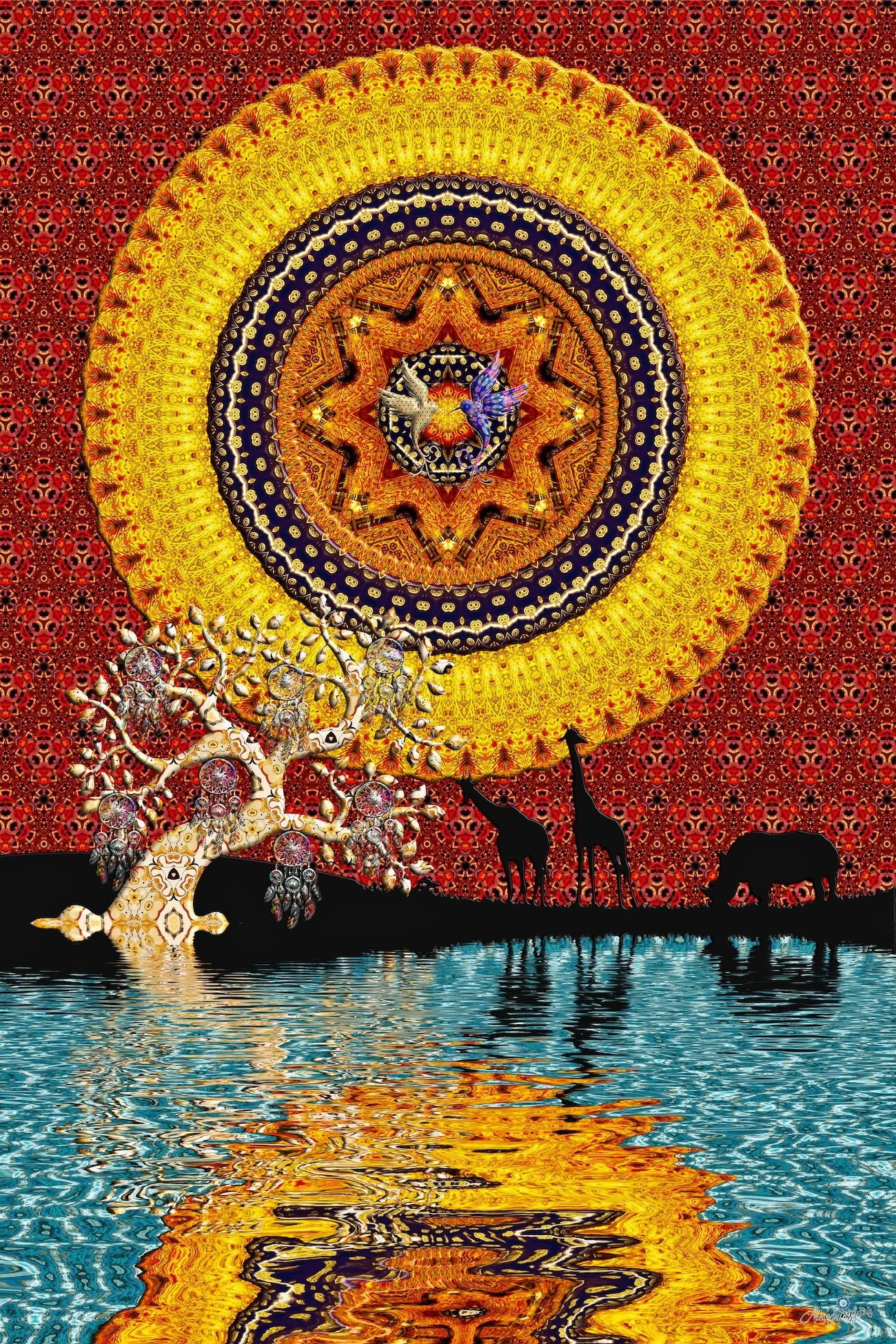Interview with Olivia-Patricia Terrell O’Neal
Olivia in her studio in Incline Village, Nevada / 2024
Olivia's Studio at Chateau St Philippe, France
Patricia Terrell was raised in Nashville, Tennessee
Attended four universities and received her Master’s Degree at the New York Academy of Art (with honors). Studied and influenced by Lewis Cohen, Martha Erlebacker, Vincent Desiderio, Steven Assael, and Carmen Cereceda. She also traveled through Italy and worked in sculpture at the studio “Cooperative in Pietresanta, Italy.
“Olivia” was born in 2019 after her husband unexpectedly died in Merida, Mx. only three months prior having just moved there. She had to be reborn. Synchronicity occurred (the truth within) when an unknown person called her Olivia- she adopted that name.
Olivia-Patricia O’Neal has maintained art studios in North Hampton, Mass. France, Mexico, and Southern California. Currently lives and works in Incline Village, Tahoe.
During her early years using her imagination- drawing was her LOVE, with a particular interest in painting portraits. Also, intrigued by a sense of WONDER, the narrative has played a strong role in her large -scale paintings. Her work expresses a sincere love for story-telling, influenced by Mary Shelley’s Frankenstein, a narrative now over 200 years- ‘death and immortality’ is still an obsession.
In a way, making ART is a means of DESIRE
Considering the profound impact that different cultural landscapes have on your work, how do you perceive the role of place in the evolution of artistic identity? Do you believe that geographic and cultural contexts serve as a canvas upon which personal and collective histories are projected, or do they act more as silent muses guiding the hand of the artist?
The cultural landscape sometimes has an unexpected influence, such as the series I created called “The Myth of Frankenstein”.
The art critic- Laurie Frank:
“The subjects of her work are born of her environment and literary imagination. In this latest series, she develops imagery from Mary Shelley’s Frankenstein, primarily a story about the fear of mortality. Each piece is inspired by her memory and subconscious reaction to the book, which O’Neal investigates in romantic palettes. The expressionistic strokes of her paint accentuate the psychological situations of the captured moments, dealing with emotional overtones of mob mentality, the murder of the innocent, guilt, intellect and perception of self. Influenced by early film, large and visionary scale (mostly 122cm+), the paintings are powerful in their expression of the basic nature of the human soul. In addition to specifically captured moments, the paintings also take on the world they were created in, the weight of the countryside, the history of the region and the magnificent beauty of the Alps.
The project began at O’Neal’s family French residence, a former monastery, Chateau St. Philippe, in Savoie, France. not far from a similar chateau high in the Alps where Mary Wollstonecraft Godwin, age 19, and her lover (later her husband) Percy Shelley, visited by Lord Byron at Village Diodati, “…Laurie Frank… where she recreated her dream.
I was moved to express through my art… that Mary Shelley at age 19 could give birth to an icon, a broken-hearted motherless monster. Born from the pain caused by the death of Dr. Victor Frankenstein’s mother.” This is a story of his consuming desire to defeat death and create immortality. A foreboding which for two hundred years remains vital and dear to our being. The paintings portend the world they were created in, the history of a region, monumentality of the landscape and the mysterious evocative power of the French Alps.
"An Artist- #38" / oil on prepared board / 18.42 x 13.34cm
Olivia painting in her Incline Valley studio (Nevada)
Your assertion that each piece is an adventure in process and substance suggests a dynamic and ever-evolving approach to creation. How do you navigate the tension between the transient, ephemeral nature of inspiration and the permanence sought in artistic expression? In what ways does this philosophical dichotomy manifest in your finished works?
As an example of “the assertion that each piece is an adventure in the process and substance suggests a dynamic and ever evolving approach to creation…” It is my hope the paintings reveal the adventure. The current small works of portraiture are examples of texture, color and substance, and of this mindful expression of the visual process. The small panels are individually prepared with pigments, plaster and exposed gauze.
I am inspired by the idea of the ARTIST as muse. Each piece is the same live model: Kelly O’Neal, while listening to emotive podcasts, I interpret her feelings. I never feel like I have any control over these paintings of portraits- don’t really have anything to do with them- they seem to paint themselves and are always a surprise- that is why I love painting these small emotive portraits--just to see what they reveal.
"Three Blind Women Crossing Wilshire Blvd"/ drawing-prepared on newsprint attached to canvas; drawn with: ink, charcoal, and gesso / 182.88 x 219.71cm
Growing up in an auditory-rich but visually sparse environment in Nashville, your exposure to live music over visual art presents an intriguing contrast. How do you think this sensory dichotomy influenced your visual perception and creative methodology? Do you find that your art seeks to translate auditory experiences into visual forms, thus creating a synesthetic dialogue between sound and sight?
Nashville provided me with both music and dance, which I call “Rhythm” as reflected in my drawings- the bases of all my work. This can be seen particularly in the large-scale drawing (182.88 x 219.71cm) prepared on newsprint attached to canvas drawn with ink, charcoal, and gesso. This piece titled “The Three Blind Women Crossing Wilshire Blvd”.
At that time I had a studio at Bergamot Station in Santa Monica, which had large white walls and an invitation to express the shock of the moment, a memory. One day as i drove along Wilshire Blvd.- all the drivers stopped while encountering three blind women holding on to each other crossing without the guide sound in the middle of the street. Alarmed! we all stopped, while they made it safely holding on to each other.
Afterwards on the prepared large-scale canvas -paper piece- I expressed the image I remembered - in Rhythm.
"The Wounded Muse" (Black and White Series) / oil on board / 121.92 x 152.40cm
The juxtaposition of your fascination with Greek and Renaissance figures against your experience in an abstract contemporary art gallery suggests a complex interplay of influences. How do you philosophically reconcile the timelessness and humanism of classical art with the abstract and often deconstructive nature of contemporary expression? In what ways does this synthesis challenge and expand your artistic narrative?
‘…the complex interplay of influences’ - My understanding of the different cultural experiences of the USA, France, and Mexico, sometimes all in one year divided between studios for 3 to 4 months at a time, did feel schizophrenic upon arrival. However, after about a week the flow of adjustment and comfort of the location would settle. The familiar sense encouraged me. Often there were unfinished paintings left behind, inspired I would find my tract. An example, “The Wounded Muse”, from the “Black and White” series at a period of transition. I had started a large monochromatic drawing, for a painting which was inspired by a small early Italian drawing that felt relevant to my situation - a drawing that seemed to reflect my dilemma. I was between countries. I had started the large-scale painting (122 x 142cm) while in my studio in Pasadena, California, with a lingering feeling from having just been in Europe and trying to connect the old with the new. The muse felt like an angel with a broken wing. The pregnant figure (creativity) was the wounded artist being carried by two other artists to be revived. I did not expect a solution or synthesis; it was all process and imagination.
"The Keening Geese" (the death of my brother) / oil on canvas / 91.44 x 127cm
Käthe Kollwitz’s focus on social imbalance and human suffering resonates deeply in your work. How do you approach the ethical responsibility of an artist in representing such profound themes? Do you believe that art has the power to not only reflect societal issues but also to enact change? How does this belief shape your creative choices and the stories you choose to tell?
Käthe Kollawitz, I believe, has a powerful influence on anyone empathetic to her emotional work. The power of the lines speak in her case stronger than words; one can hardly deny her passionate imagery done with lines. Her drawings are able to embrace the pain she felt from experience. Every stroke is like a dagger to the heart. Even without empathy one can SEE another’s broken heart. She reflects visually her experience. I can believe it. Her art does that. A heart may not be opened but it can be touched. She as an artist does that. Yes, I believe she not only “reflects societal issues”, she through drawing encourages other artist like myself that PASSION shown through art can encourage HOPE for understanding.
If EVIL, can be described, is without LOVE then LOVE must be without EVIL. Goya also offers this concept in his late paintings.
I went to Madrid, without disappointment, just to see the POWER, the PASSION of his work.
"Karl Lagerfeld" (Shades Series) / oil on Linen / 22.9 x 17.15cm
The use of masks and sunglasses in your portraits introduces a layer of anonymity and mystery. How do you perceive the philosophical implications of concealed identities in your work? What do these motifs reveal about your views on the nature of self, perception, and the human condition? How do they invite viewers to question the authenticity of what is seen versus what is hidden?
Sunglasses have been associated with Hollywood for a long time; an area of L.A. where I lived. Absorbed by the significance, sunglasses can be used to express style, to protect, to enhance, to add mystery or mystique. Models, movie stars, magazines of contemporary life celebrate and elevate DESIRE. The multitude of designs and fabulousness of the look make them fashionable, desirable or used as a disguise. I wanted to examine this concept.
I have been interested in the mask of ancient times and studied the many different cultural interpretations of MASKS for my book "Look and See".
It was interesting to associate the sunglasses (shades) with the concept of Masks. Clearly many cultures used masks to conceal, reveal, and protect as well as symbolize, animal and ancestor worship. The concept of this kind of worship fascinated me. In my paintings I wanted to see what I could express without showing the eyes. I envision people with sunglasses as a means of being something they want to be or to hide who they are. I could imagine them in paintings and define their masks.
Like Karl Lagerfeld, a person who created his own "brand", which no one can copy without thinking of him. His style could not be “Him” without the glasses- a worthy subject.
“Man is least himself when he talks in his own person. Give him a mask, and he will tell the truth.” -Oscar Wilde
"Mother Goose" / oil on panel / 162.56 x 127cm
"The Widow" (Mexican Memories) / oil on linen / 60.96 x 60.96cm
The diverse cultural stimuli from living in the USA, France, and Mexico present a rich tapestry of influences. How do you philosophically integrate these disparate cultural elements into a unified artistic vision? Do you see your work as a dialogue between these cultures, and if so, how do you navigate the potential for cultural appropriation while honoring the distinctiveness of each?
The diverse cultural stimuli in the USA, France, Mexico…how do I philosophically integrate… the cultural elements…’
Most influential is the USA where I was born and raised. The painting that I identify with -an important memory- is “MOTHER GOOSE”. As a young mother on the move, from one state to another, the three children were “in hand,” always with me- I felt like a goose with my ducklings FOLLOWING. This inspired the painting.
It was not my need to compare or unify the differences between the US., FRANCE, and MEXICO; I always maintain the inspiration wherever I landed which in some cases depends on the location but in others it may be totally separate.
For example, the one I call “The Widow” was inspired by the intense feelings of loss that happened while in Merida, Mexico.
The fact that my husband unexpectedly died after only 3 months of us moving there. My studio was not even finished when he passed. I stayed on and was compelled to make this simple painting showing the last gift he gave me before we left the States- Paloma Picasso’s earrings. While I stayed on in Merida, my studio was not quite finished when Covid hit and my family encouraged me to return to my home country. Leaving behind an intense love and admiration for Mexico where I had lived off and on from 2005- 2019.
Note: The inevitable influence of France continues; having lived there part time every year since 1985. Most of my early plein-air paintings were done in Flavigny sur Ozerain where I had a studio from 1987 until 2002. Since that time, I have been working in the Savoie region of the Alps, a studio which is in an early converted monastery- Chateau St Philippe (belonging to my family Chuck and Sukeshi O’Neal).
"The Sheep"/ sculpture made from hydrocal / 50.8 x 73.66cm
Your intricate technique, combining traditional methods with various materials, suggests a deep engagement with the physicality of art-making. How does this labor-intensive process reflect your broader philosophical views on the nature of creativity and the artist’s relationship to their medium? Do you see this meticulous approach as a form of meditation or a ritual that imbues your work with a deeper significance?
The ‘intricate technique’ came from my experience with sculpture. Years before while in Pietresanta, Italy working with clay and lost cast mold making - a hand intensive work- it seemed satisfying. Eventually I gave up making sculptures, it was not conducive to a transient lifestyle- painting was easier. I never lost my love for the tactile hand work of sculpture, currently I use tools such as: palette knives, sand paper, wax, and plaster; it is naturally for me more exciting.
"The Creature" (Frankenstein Series) / mixed media oil on hand prepared linen/ 116.84 x 106.68cm
"The Kiss 1" (Frankenstein Series) / oil on linen attached to panel / 142.24 x 121.41cm (How the monster sees himself)
"The Kiss 2" (Frankenstein Series) / on linen attached to panel/ 132.1 x 102cm (How the monster is seen by others)
The themes of ambition, creation, and the quest for love and acceptance in Mary Shelley’s "Frankenstein" parallel your exploration of human experience. How do you philosophically interpret these themes within the context of your own artistic journey? In what ways do these literary influences help you navigate the existential questions that arise in your practice?
“THE MYTH OF FRANKENSTEIN” was introduced by Laurie Frank
I am using her description to express my own feelings of how I interpret existential questions in my narrative work - in particular the series of paintings on exhibition- "The Myth of Frankenstein".
“I was struck dumb when I first saw Patricia Terrell O’Neal’s …paintings. For me, these paintings did what great art should always do, shocked me into recognition of a dazzling pain so pure as to become exquisite. Paintings nowadays is not supposed to be plainly narrative, but I experienced this body of work as a gorgeous abstraction, not of image but of emotion, a geometry not of text, but of subtext. They reminded me of Goya. These paintings let me hear the lonely howl of these monsters, the creator and the created with his exploded soul, and to really see what is most buried and hidden, not in them, but in me.” - Laurie Frank
Her understanding reveals how I approach much of my work- basically through my subconscious mind in conjunction with a deliberate need to discover an inner meaning that can be revealed.
"Family of Eggs" (Egg Series) / oil on linen / 81.3 x 138.43cm
Your early tactile experiences on your grandparents' farm seem to have profoundly shaped your connection to materials and process. How do these formative experiences inform your understanding of the relationship between the artist and their medium? Do you see a philosophical link between the organic, cyclical nature of farm life and the iterative, evolving process of creating art? How do these experiences continue to influence your thematic explorations and artistic techniques?
Since I was raised in Nashville and visited my grandparents. As farmers I watched as they made everything they needed. There was a distinct difference from old world to modern life of the city, from handwork to machine, from convenience to basic needs to exist. It was clear later that the influence on me was not only visual but sensual, on the farm survival depended on attention to smell, taste, touch, motivation. Ingenuity was essential for tending to the gardens, animals, provisions of food and for their materials of existence. This prepared me for unexpected difficulties, to find a way to explore techniques with determination to satisfy my dreams and rely on my own ingenuity. I use the image of eggs as a symbol for creativity.


















